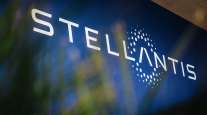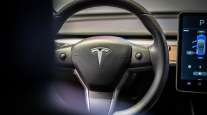Chattanooga (Tenn.) Times Free Press
For Tesla Owners, Colonial Pipeline Hack Was No Big Deal

[Stay on top of transportation news: Get TTNews in your inbox.]
Charles “Chip” Monk of East Brainerd, Tenn., watched people filling up plastic bags with gasoline on TV earlier in May and thought, “OMG.” Monk and his wife, Sandy, drive Tesla electric vehicles, so the Colonial Pipeline hacking ordeal and the panic gasoline-buying that followed were nonevents to them.
“I haven’t bought gasoline for I don’t know how long,” said Monk, an early adopter of electric vehicles who purchased his first Tesla Model S in 2013.
The retired Army Sgt. 1st Class treated himself to the super-sleek, six-figure sedan and never looked back. A few years later, Sandy traded in her gas-powered car for a Tesla Model 3, a smaller, more economical EV. Monk sold his original blue Model S and bought a new red one in 2019.
Charles "Chip" Monk of East Brainerd watched people filling up plastic bags with gasoline on TV earlier this month and thought, "OMG."
https://t.co/t1QH4ojb5G — Times Free Press (@TimesFreePress) May 24, 2021
What’s more, the Monks have a solar panel array on the roof of their home that produces electricity. According to Chip’s spreadsheets, he sells about $3.45 a day in electricity to the Tennessee Valley Authority, which offsets his power bill.
“For over six years I had no electric bill, whatsoever,” he said. “Just in the last few months we have had a little bill.”
When his neighbors were scrambling for gasoline earlier this month, Monk offered to give them rides.
“I actually talked to my neighbors and said, ‘I know there is a gas shortage. If you need a ride somewhere, let me know,’ ” he said. “I think some of them thought I was rubbing their faces in it. But my intent was not that at all. I wanted to assist folks.”
Automotive historians may look back on May 2021 as a tipping point in the evolution of electric vehicles. The Colonial hack and resulting run on filling stations reminded people of the fragility of petroleum supply lines.
Meanwhile, Ford Motor Co. introduced its new electric F-150 pickup truck last week, an important move designed to move EV technology into the mainstream. Autoweek reports that if the F-150 were its own brand, it would be bigger than McDonald’s or 3M.
Ford sells about 900,000 of the popular pickups each year, so if even a small fraction of F-150 loyalists opt for the electric version, called the Lightning, it would be a game-changer for the EV segment.
People will come to appreciate the low-maintenance costs associated with EVs, experts predict. Monk said he sold his first Tesla at 140,000 miles and his only parts costs were windshield wipers, windshield cleaning fluid and tires.
In the meantime, the Monks represent what life could be like for EV families in the near future. Chip installed a “Tesla power wall” in his garage that makes for faster recharging, and he can store enough power from his roof panels to get through a three-day electric outage. In fact, he admits to being a little peeved that a thunderstorm hasn’t interrupted power since he got his system up and running.
When a truck hit a power pole and knocked out neighborhood power for eight minutes, Monk was ecstatic that his backup power system never missed a beat.

Next-level technologies hold the potential to enhance safety and efficiency in transportation, but it takes a lot of work behind the scenes to advance these ideas from concept to reality. We talk with Christoph Mertz of the Robotics Institute at Carnegie Mellon and Huei Peng of the University of Michigan. Hear a snippet above, and get the full program by going to RoadSigns.TTNews.com.
Monk said the Tesla message boards online were full of gloating EV owners during the gas shortage. But he believes owners of electric vehicles should be evangelists, not antagonists.
He said he used to offer ride-shares through Uber, not to make money, but to introduce others to the awesome driving dynamics of his Tesla.
“To promote people getting off petroleum, we need to be the right kind of people,” Monk said of EV owners.
Some people think driving range is the EV bugaboo, but Monk has driven to California, Texas and Niagara Falls, among other places, in his Tesla. He uses the company’s network of fast chargers to juice his Model S in under an hour.
All things considered, being petroleum-free has lowered his stress, Monk said.
“It gives me real confidence and just a peaceful state of mind,” he said.
Want more news? Listen to today's daily briefing below or go here for more info:
Distributed by Tribune Content Agency, LLC




